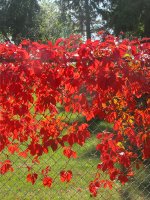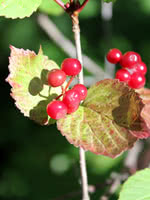Mon-Fri 9am - 5pm Mountain time
Virginia Creeper vs Lowbush Cranberry
Parthenocissus quinquefolia
Viburnum edule
NOT AVAILABLE THIS SEASON - MIGHT RETURN
Virginia Creeper is a fast-growing, climbing vine. Its root-like tendrils attach themselves to any non-smooth surface, even brick, but will also grow as a ground cover.
Virginia Creeper makes a beautiful ornamental plant for your garden; its attractive foliage turns from green to deep red in the fall. Birds will love its red berries.
Lowbush Cranberry is a short, deciduous shrub native to North America. Its white flowers bear sour but edible fruit that ripens to a brilliant red in fall. Lowbush Cranberry's small size makes it suitable for urban use; buyers will also find it useful if trying to reclaim land back to its original species or when landscaping with native species in damp conditions.
Virginia Creeper Quick Facts
Lowbush Cranberry Quick Facts
Toxicity: berries are toxic

